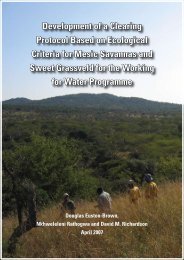Business Case forthe Pongola-Umzimkulu Catchment Management ...
Business Case forthe Pongola-Umzimkulu Catchment Management ...
Business Case forthe Pongola-Umzimkulu Catchment Management ...
You also want an ePaper? Increase the reach of your titles
YUMPU automatically turns print PDFs into web optimized ePapers that Google loves.
<strong>Business</strong> <strong>Case</strong> for the <strong>Pongola</strong>-<strong>Umzimkulu</strong> <strong>Catchment</strong> <strong>Management</strong> Agency<br />
• The principle that a WMI cannot regulate or audit itself.<br />
Based on these principles, and the identification of those functions that a CMA would not<br />
perform, the water resources management functions may be delegated and performed by a<br />
fully functional CMA are outlined below.<br />
Develop Policy & Strategy<br />
The formulation of policy and legislation will remain a DWA function, to which a CMA would<br />
provide input. At the strategy level, a CMA is responsible for the development of a<br />
catchment management strategy, as well as financial and business planning for the<br />
organisation.<br />
DWA will continue to:<br />
• Develop legislation, methodology and guidelines to enable WRM.<br />
• Develop the national water resources strategy, the pricing strategy and the institutional<br />
roles and responsibilities.<br />
• Determine the water resources class, as well as the Reserve and RQOs in resources of<br />
national significance 11 .<br />
In some cases, DWAF may delegate the determination of the Reserve and resource quality<br />
objectives (RQOs) to the CMA for those resources that are not considered to be of national<br />
significance.<br />
Regulate Water Use<br />
A fully functional CMA will perform most of the responsible authority functions in relation to<br />
authorising and enforcing water use, and setting and collecting water use charges. However,<br />
DWA will retain authorisation and allocation of water for strategic purposes, inter-WMA<br />
transfers and where the CMA is the proposed water user.<br />
Water use registration, validation and verification will be done by the CMA. DWA will,<br />
however, maintain the national WARMS database and CMAs will have to provide the<br />
information to DWA for this.<br />
Establish, Support and Regulate Institutions<br />
DWA will remain responsible for the establishment, support and regulation of CMAs, Water<br />
User Associations that manage government waterworks or have government guaranteed<br />
loans, and any national level bodies such as the TCTA and WRC. DWA will also be<br />
responsible for inter-WMA coordination and conflict resolution.<br />
A CMA may establish, regulate and support water management institutions that have been<br />
specified in its catchment management strategy, such as water user associations, as long as<br />
these do not manage government water schemes or have government guaranteed loans.<br />
The CMA is obliged to coordinate water related activities of institutions and ensure<br />
community participation in WRM within the WMA.<br />
11 This concept has not been defined, and must be defined in order to be able to distinguish between what will be done by DWA and what by<br />
the CMA<br />
Department of Water Affairs 25
















